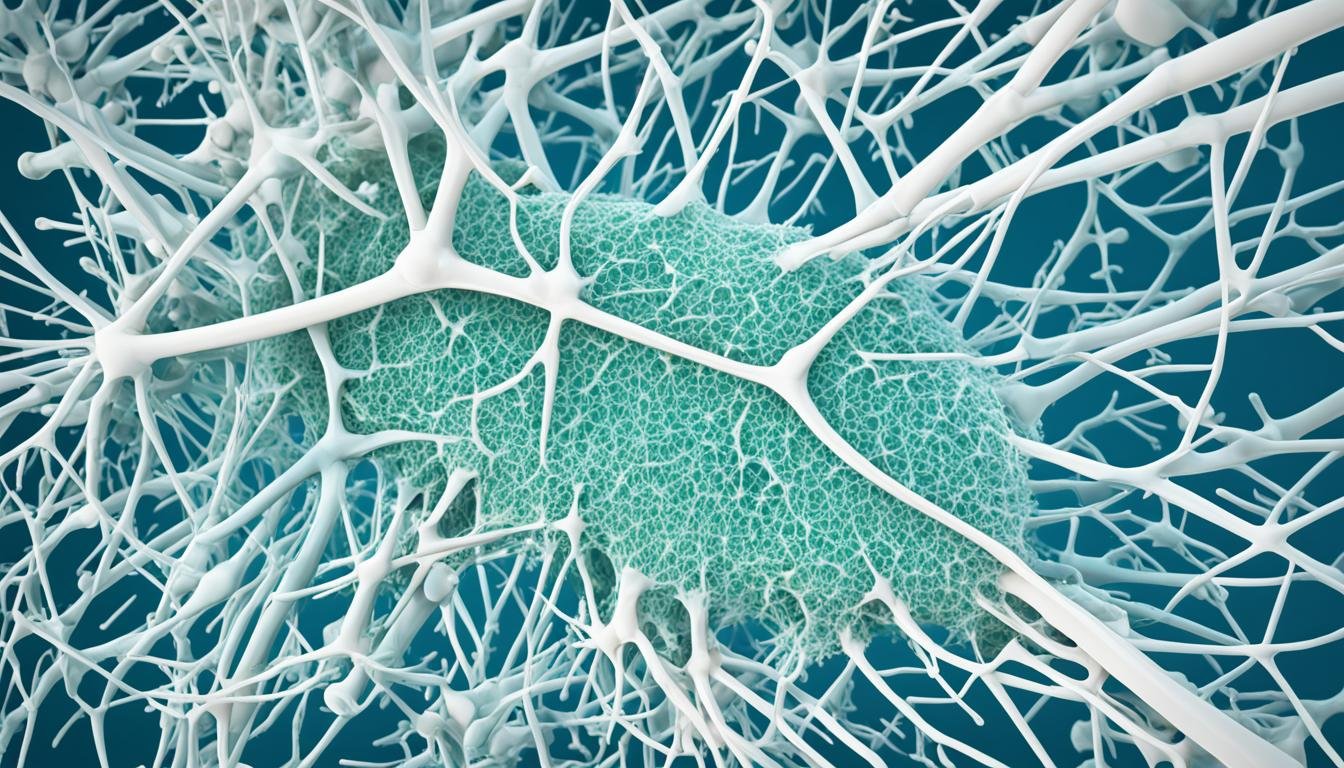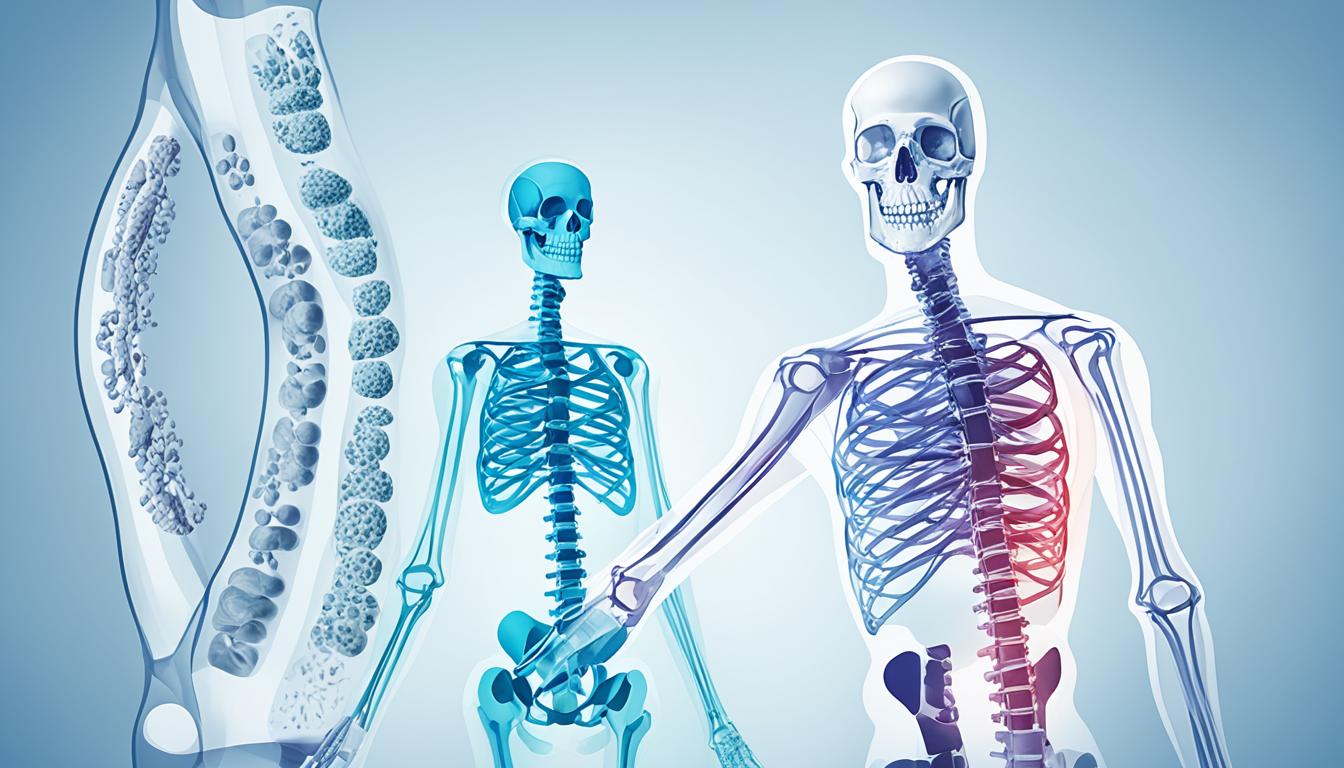Did you know bone spicules are tiny bone pieces? They matter a lot for our bone health. They can cause different bone problems. These small bits are very important for our bones.
We will dive into the world of bone spicules. We will look at what they are, how they form, and their role in bone health. We’ll find out why they happen, how they affect us, and how to deal with them. This will help keep our bones healthy.
Key Takeaways:
- Bone spicules are tiny fragments of bone that can significantly affect bone health.
- Understanding the anatomy and formation of bone spicules is crucial to grasp their significance in bone pathology.
- Various factors can contribute to the formation of bone spicules, leading to bone complications.
- Bone spicules can have adverse effects on bone health, requiring effective strategies for management.
- By delving into the world of bone spicules and their intricate nature, we can work towards promoting optimal bone health.
Understanding Bone Spicules: Structure and Formation
Let’s explore the world of bone spicules. We’ll look at how they’re made and what they do. Understanding these small parts helps us learn about bones.
The Structure of Bone Spicules
Bone spicules are unique and important for our bones. They are made of strong fibers that lock together. This design gives bones strength but also lets them bend.
Deep in the bone, spicules create a strong pattern. This pattern helps the bone handle weight and stress well.
Formation and Histology of Bone Spicules
The creation of bone spicules is a special process. Cells called osteoblasts start it off by making a foundation. On this foundation, minerals add up to make the spicule.
As they grow, bone spicules get some mature cells called osteocytes inside them. These cells keep the spicules healthy. They make sure nutrients come in and waste goes out.
The way bone spicules are built is amazing. They have lots of collagen fibers held together by minerals. This makes the bones strong and able to handle a lot.
Cells Involved in Bone Spicule Formation
Many kinds of cells work together to make bone spicules. Osteoblasts are key. They start by making a base for the spicules. These cells come from special stem cells.
Osteocytes also play a big role. They live in the bone, keeping an eye on stress. They help make sure the bone stays healthy and strong.
Learning about these cells teaches us how bones grow and fix themselves. It’s really interesting!
| Cell Type | Function |
|---|---|
| Osteoblasts | Produce the initial matrix for bone spicules formation |
| Osteocytes | Maintain bone spicules and facilitate bone remodeling |
The Role of Bone Spicules in Bone Development
Bone spicules are very important for bone growth and reshaping. These small structures help our bones be strong. They form during bone changes, adding to our skeleton’s strength.
Old bone tissue gets broken down by osteoclast cells. Then, osteoblast cells create new bone. This change keeps our bones healthy and strong.
Bone spicules start to form as osteoblasts work. They lay down new bone, which then hardens. These connections help support the bone.
Bone spicules also help with bone shaping. They give something for osteocytes to hold onto. Osteocytes are key for bone health. They sense stress and manage bone tissue work.
Osteocytes talk to each other using tiny canals. They also communicate with osteoblasts and osteoclasts. This teamwork ensures our bones are renewed properly.
Bone spicules and cells work together closely. This teamwork keeps our bones healthy. If something goes wrong, we may get bone diseases.
In summary, bone spicules are very important. They help our bones stay strong and talk to each other.
Causes of Bone Spicules Formation
Bone spicules form because of problems with the bones. Bone pathology includes many diseases and disorders. They mess up how bones work and look, leading to spicules.
Osteoporosis makes bones weak and can cause spicules. This condition makes bones less dense and easy to break. The body tries to fix this by forming bone spicules.
Bone tumors are another reason for spicules. Tumors damage bones, creating spicules in response. This happens as the body tries to fight the tumors.
Bone infections like osteomyelitis can also lead to spicules. These infections inflame and damage bones. Healing from this damage often involves spicule formation.
Other Contributing Factors
Other things can also make bone spicules more likely. These include:
- Not getting enough nutrients, like calcium and vitamin D, is bad for bones.
- Changes in hormones, especially less estrogen in women after menopause, speed up bone loss.
- Some people’s genes make them more prone to bone problems and spicules.
- Long-term diseases like rheumatoid arthritis hurt bone health and can cause spicules.
Doctors need to know these causes and factors to help patients with bone spicules. Finding and treating bone spicules early is key to keeping bones healthy.

Effects of Bone Spicules on Bone Health
Understanding bone spicules is key for bone health. These small fragments impact our bones big time. Let’s look at how they affect our bones.
1. Impaired Bone Strength
Bone spicules make bones weaker and more likely to break. Their sharp edges cut down on bone strength and stability. This can make moving harder and increase fracture risks.
2. Disrupted Bone Remodeling
Healthy bones need constant renewal, called remodeling. But, bone spicules mess this up. They block the cells that keep bone renewing balanced. This causes too much bone breakdown.
3. Bone Inflammation
Bone spicules can also cause swelling in bones. This swelling makes bones weaker and worsens health. It’s a big problem for bone strength.
To show bone spicules’ effects, here’s a table:
| Effect | Description |
|---|---|
| Impaired Bone Strength | Weaker bones, higher fracture chance |
| Disrupted Bone Remodeling | Too much bone breakdown |
| Bone Inflammation | Swelling in bones |
Bone spicules hurt bone health in many ways. Knowing this helps us find better treatments and care.
Diagnosing Bone Spicules: Medical Significance
Diagnosing bone spicules helps us understand bone growth and sickness. By studying bone spicules, doctors can learn about different health issues. This can help prevent future problems.
Doctors often use X-rays and CT scans to find bone spicules. These tools show the bones in great detail. This helps doctors see where the spicules are.
Bone spicules are very important for bone health. They help bones stay strong by being part of the bone remodeling process. This keeps our bones in good shape.
Knowing about bone spicules is key for bone experts and doctors. Recognizing these spicules helps in planning the right treatment. This can improve bone health and avoid serious issues.
To diagnose bone spicules, doctors look at many things. They check the patient’s history, exam results, and lab tests. This full check helps make a clear diagnosis.
Once found, bone spicules give important clues about a person’s bone health. They can show if there’s a bone problem that needs more attention.
In short, bone spicules tell us a lot about bones and their health. Finding them through special tests and deep checks is crucial. It helps doctors care for their patients better.
Treatment Options for Bone Spicules
There are good treatments for bone spicules to help bone health. With the best care, people can feel better and have healthier bones.
1. Medication: Doctors may give medicine for bone spicules symptoms. NSAIDs lessen swelling and pain. Bisphosphonates keep bones strong and slow bone loss.
2. Physical Therapy: This is important for treating bone spicules. Therapists make exercise plans to strengthen muscles, improve flexibility, and ease pain. It helps people move better and feel happier.
3. Orthotic Devices: Sometimes, devices like shoe inserts or braces are needed. They support and ease pressure on bones. This makes walking easier and less painful.
4. Surgery: For tough cases, surgery might be needed. Doctors might suggest bone grafting or joint replacement. This can fix bone spicules and reduce symptoms.
Important Considerations
It’s crucial to consult with a healthcare professional to determine the most appropriate treatment options for bone spicules. Each case is unique, and the treatment plan should be tailored to the individual’s specific needs and circumstances.

Treatment options offer a path to manage bone spicules and better bone health. Early action is vital. It helps tackle bone spicules early and keep you healthy.
Managing Bone Spicules for Optimal Bone Health
Managing bone spicules is key for good bone health. These small bone fragments, or bone spicules, affect your bones. With some lifestyle changes, you can help your bones stay healthy.
1. Prioritize Bone Health
Eating right and exercising helps manage bone spicules. A diet rich in calcium and vitamin D strengthens bones. Activities like walking or jogging are good for your bones too.
2. Seek Medical Guidance
If you think you have bone spicules, see a doctor. They can help with treatment plans. This will address your bone health needs.
3. Implement Lifestyle Modifications
Changing your lifestyle can manage bone spicules. Drink less alcohol and stop smoking for healthier bones. Staying active and keeping a healthy weight is also key.
Using these strategies can help you take care of your bones. It’s a way to manage bone spicules and keep bones healthy.
Taking care of your bones is important throughout life. Focus on bone health, get medical advice, and make lifestyle changes. This will help you have strong bones forever. Start taking steps for better bone health today.
Exploring Bone Spicules Under the Microscope
Looking at bone spicules under a microscope helps us understand their structure. This lets researchers learn more about their effects on bone health.
Bone spicules’ tiny details become clear under a microscope. We can see their cell setup and outer matrix. These details help us understand how bone spicules form.
One interesting thing seen is the 3D network inside bone spicules. These networks help bones be strong. How these networks connect can tell us about the health of the bones.
Looking closely at bone spicules reveals their complex beauty. We see a fine network and how cells and matrix work together. This fascinates scientists all over.
We can also see osteocytes and osteoblasts in bone spicules. These cells are key in bone remodeling. Seeing these cells helps researchers understand bone spicule growth.
Studying bone spicules this way aids in diagnosing bone issues. It also helps in finding treatments. Knowing the problems in their structure, doctors can find better treatments.
Unveiling the Intricacies of Bone Spicules
Microscopes show us the amazing details of bone spicules. We can observe:
- How trabeculae are arranged and connected
- The activity of osteocytes and osteoblasts
- The makeup of the extracellular matrix
- How dense and spread out the bone spicules are
Looking at these tiny details gives professionals valuable info. This helps them make plans for treating and managing bone health.
Conclusion
Bone spicules are super interesting in keeping our bones healthy and figuring out diseases. We learn a lot by studying their shape, how they form, and why they matter. This helps us keep our bones strong and deal with bone spicules better.
People with bone spicules can find good ways to feel better. They might change how they live or do things to keep their bones healthy. These steps are important for strong bones.
Doctors pay close attention to bone spicules to understand our bones better. They use this info to stop bone problems before they start. And they find the best ways to treat them.

